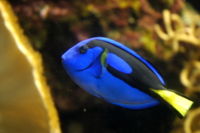Difference between revisions of "Paracanthurus hepatus"
From The Aquarium Wiki
(→Origin) |
|||
| Line 38: | Line 38: | ||
== Origin == | == Origin == | ||
| − | :Indo-Pacific: East Africa, including the Mascarene Islands to Kiribati, north to southern Japan, south to the southern Great Barrier Reef, New Caledonia, and Samoa. | + | :Indo-Pacific: East Africa, including the Mascarene Islands to Kiribati, north to southern Japan, south to the southern Great Barrier Reef, New Caledonia, and Samoa. As one name implies, these fish live in the Pacific Ocean, but they are also found in the Indian Ocean, from East Africa to Micronesia, according to the International Union for Conservation of Nature (IUCN). Their homes are the coral reefs that grow along the shores. |
| − | |||
== Tank compatibility == | == Tank compatibility == | ||
:A reasonably peaceful fish that is usually reef compatible. Should not be kept with other Tangs as it may be territorial towards others of both its own species and those of similar shape. | :A reasonably peaceful fish that is usually reef compatible. Should not be kept with other Tangs as it may be territorial towards others of both its own species and those of similar shape. | ||
Revision as of 03:56, 30 November 2020
Regal Tang
Paracanthurus hepatus
681 Litres (180 US G.)
27.9-30.5cm (11-12 ")
8.1 - 8.5
22.2-25.6°C (72 -78 °F)
8-10 °d
1:1 M:F
8-12 years
Family
Acanthuridae
Error creating thumbnail: Unable to save thumbnail to destination |
You can contribute to the Aquarium Wiki by expanding this article. Dont be shy!. |
Contents
Additional names
- Blue Tang, Pacific Blue Tang, Regal Tang, Hippo Tang, Palette Surgeonfish, Yellowtail Tang, Dory
Additional scientific names
- Teuthis hepatus, Acanthurus hepatus, Acanthurus theuthis, Paracanthurus theuthis
Origin
- Indo-Pacific: East Africa, including the Mascarene Islands to Kiribati, north to southern Japan, south to the southern Great Barrier Reef, New Caledonia, and Samoa. As one name implies, these fish live in the Pacific Ocean, but they are also found in the Indian Ocean, from East Africa to Micronesia, according to the International Union for Conservation of Nature (IUCN). Their homes are the coral reefs that grow along the shores.
Tank compatibility
- A reasonably peaceful fish that is usually reef compatible. Should not be kept with other Tangs as it may be territorial towards others of both its own species and those of similar shape.
Diet
- Mostly Plankivorous in the wild, it will eat most foods, and prefers a varied diet including vegetable matter. Will take mysis shrimp, blanched vegetables and prepared foods.
Feeding regime
- Feed once or twice a day.
Environment specifics
- Needs a large and spacious tank with places to hide and open spaces to swim.
Behaviour
- An active and curious fish that often has a distinct personality. This fish has often been known to "play dead" a lot when first added into the tank. Will often wedge itself into deep crevices, especially when young. Even though they may appear stuck at times, they will not wedge themselves into something they can't get out of.
Identification
- Thanks to the film 'Finding Nemo', the Regal Tang is now easily identified by most people. It's base colour is a vivid blue/purple with a darker blue/black band across the top half of the body, the pattern will vary from fish to fish. The caudal fin is yellow and outlined in black and the pectoral fins are also tipped with yellow.
Pictures
Videos
External links
- Fishbase (Mirrors: Error creating thumbnail: Unable to save thumbnail to destination)


